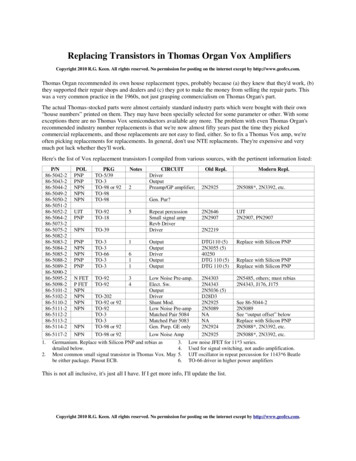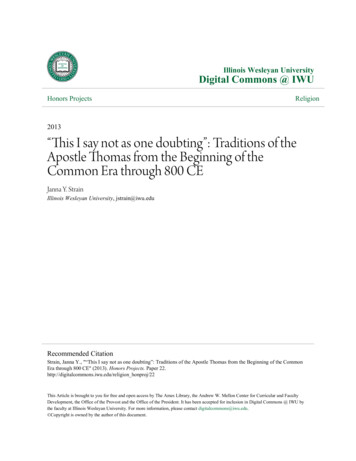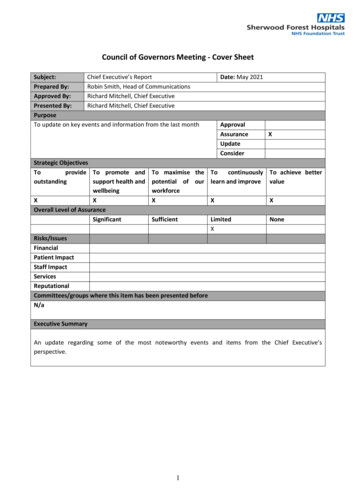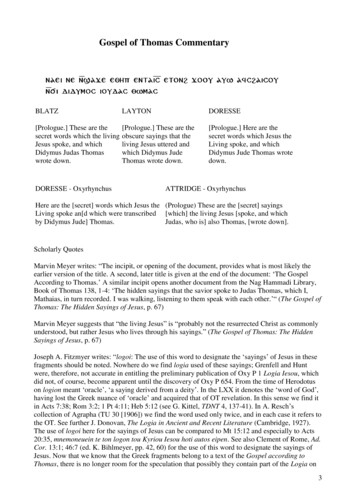
Transcription
Replacing Transistors in Thomas Organ Vox AmplifiersCopyright 2010 R.G. Keen. All rights reserved. No permission for posting on the internet except by http://www.geofex.com.Thomas Organ recommended its own house replacement types, probably because (a) they knew that they'd work, (b)they supported their repair shops and dealers and (c) they got to make the money from selling the repair parts. Thiswas a very common practice in the 1960s, not just grasping commercialism on Thomas Organ's part.The actual Thomas-stocked parts were almost certainly standard industry parts which were bought with their own“house numbers” printed on them. They may have been specially selected for some parameter or other. With someexceptions there are no Thomas Vox semiconductors available any more. The problem with even Thomas Organ'srecommended industry number replacements is that we're now almost fifty years past the time they pickedcommercial replacements, and those replacements are not easy to find, either. So to fix a Thomas Vox amp, we'reoften picking replacements for replacements. In general, don't use NTE replacments. They're expensive and verymuch pot luck whether they'll work.Here's the list of Vox replacement transistors I compiled from various sources, with the pertinent information PNPNPNNPNNPNPKGTO-5/39TO-3TO-98 or PTO-3TO-3TO-66TO-3TO-3611N FETP FETNPNNPNNPNNPNTO-92TO-9234NPNTO-202TO-92 or 92TO-92TO-3TO-3TO-98 or 92Notes2CIRCUITDriverOutputPreamp/GP amplifier;Old Repl.Modern Repl.2N29252N5088*, 2N3392, etc.Repeat percussionSmall signal ampRevb DriverDriver2N26462N2907UJT2N2907, PN2907OutputOutputDriverOutputOutputDTG110 (5)2N3055 (5)40250DTG 110 (5)DTG 110 (5)Replace with Silicon PNPLow Noise Pre-amp.Elect. Sw.OutputDriverShunt Mod.Low Noise Pre-ampMatched Pair 5084Matched Pair 5083Gen. Purp. GE only2N43032N43432N5036 (5)D28D32N29252N5089NANA2N29242N5485, others; must rebias2N4343, J176, J175Gen. Pur?5186-5117-2 NPNTO-98 or 92Low Noise Amp1. Germanium. Replace with Silicon PNP and rebias as3.detailed below.4.2. Most common small signal transistor in Thomas Vox. May 5.be either package. Pinout ECB.6.2N2219Replace with Silicon PNPReplace with Silicon PNPSee 86-5044-22N5089See “output offset” belowReplace with Silicon PNP2N5088*, 2N3392, etc.2N29252N5088*, 2N3392, etc.Low noise JFET for 11*3 series.Used for signal switching, not audio amplification.UJT oscillator in repeat percussion for 1143*6 BeatleTO-66 driver in higher power amplifiersThis is not all inclusive, it's just all I have. If I get more info, I'll update the list.Copyright 2010 R.G. Keen. All rights reserved. No permission for posting on the internet except by http://www.geofex.com.
Small Signal BipolarsThe small signal bipolars can mostly be replaced with any modern NPN silicon low noise device. Modernreplacements should be low-noise NPN with hfe between 200-400.The 86-5044-2 is the most common device used in these amps. It's an ECB pinout, like the 2N3391, many BCxxxseries and Japanese 2SCxxxx. You can use EBC by bending pins. The pins are usually bent funny on the originals,so this is not too worrisome.It's likely that Thomas Organ used some sorted/selected version of the 2N2925 device for many of its part numbers.You can still find 2N2925s, but it's unknown what they may have specified as a selection (if any) to the maker of thetransistor, so even a “real” 2N2925 may not identically match the original device. Use a 2N5088, 2SC1815, BC549,or similar, and note the differences in the pinout, being sure you get the right pin in the right hole. In many ways, the2SC1815 is ideal. It's got the ECB pinout of the original TO-98 transistors, high gain, and can pull more current thana 2N5088, even if it's a db or so more noisy.For the 86-5111-2, most small signal low noise NPNs will work if you get the pinout correct. I like the 2N5088 anduse it everywhere. You can also use the BC107/108/109, and many others. Likewise for the other low signal NPNsilicons.Driver TransistorsThe three driver transistors listed are the 86-5042-2, 86-573-2, 86-5075, the 86-5085, and the 86-5102. Drivers aremedium power devices, intended for more current than small signal amplification, but less than driving speakers.They have been called “uniwatt” devices by some makers, to indicate that they're typically capable of one to a fewwatts of power. In the 60's, these were generally TO-39 package; this is superceded by the TO-126 or TO-202.On the drivers, I'd use a Toshiba 2SC4793 or 2SC5171. They're made for audio drivers, and are fast, high gain, andtough. They can replace all of the listed drivers. These are probably my first choice.Some other guesses are: BD175/177/179, BD233/235/237, BD439/441 in the TO-126 uniwatt package, althoughthese are a bit low gain, and slower (lower ft) than the 2219. They'll probably work. In a pinch I'd try the MJE340.In the TO220 package, try the KSD880 (Fairchild), BD243B/C, BD239B/C or the KSC2073.The 86-5102-2 is a problem. The original is quite a high gain device, and the other replacements may not give goodresults. Still working on this one.JFETsThe JFETs from Thomas are what motivated me to write this. JFETs are kind of a bad dream for E.E.s. They're sovariable that it's really hard to design well with them.The 86-5095-2 N-channel is used as a low noise input device in the V11x3*6 models. Thomas suggests the2N4303, which is still available, but not all that common. Some commercial cross references for that part numberare 2N4416, 2N5245, 2N5362, 2N5458, and 2N5459.Almost all commercial JFETs have high enough voltage ratings. But you do need to know a JFET's Idss, Vgsoff,and transconductance. Idss is the largest current a JFET will conduct. Vgsoff is the voltage which turns it completelyoff, and transconductance is the current that flows in the channel per volt of change on the gate.I found that the JFETs I had did not work well in the Thomas preamps. In fact, a 2N4303 that I came up with did notwork. So I ran some simulation models so I could diddle with the JFET parameters. What seems to be important inthe low-noise preamp spot for the 86-5095-2 is that Idss has to be over 5ma and Vgsoff is over 3V. There are manyJFETs that do this. However, the other thing that matters is transconductance, and all my JFETs were biasing thebipolar PNP that followed them incorrectly. They were pulling too much current through the base of the transistor.Copyright 2010 R.G. Keen. All rights reserved. No permission for posting on the internet except by http://www.geofex.com.
The DC feedback in the circuit is supposed to fix this, but doesnot in all cases. I found that I had to tune the circuit to match theJFET I put in, even if it's a recommended replacement type. Inthe Thomas Vox amps, this means varying the value of theresistor from base to emitter of the PNP that the N-JFET drivesin the preamps of the 11x3*6 preamp series. In the exampleschematic at right, the normal channel from the 1143*6, thiswould be R105. This is nominally 1.2K. Using values from 220ohms to 4.7K, I could tune in most of the JFETs I tried. Thetrick is to measure the voltage from the PNP collector to groundand change the base-emitter resistor so the collector is roughlyin the middle of the power supply, or alternately that the sourceof the JFET is about 1.5-2.0V. You have to get the DC voltageon the PNP transistor collector away from ground enough to notdistort the signal; It's only a couple of volts here, so this is not hard.The P-channel JFET is only used for signal routing/switching in the 11*3 series of amps. Thomas lists 2N4343, andthe commercial replacement I found listed was BFT11. However, a J175/176 worked fine in my boards. Not beingused in analog mode for amplifying means that all you have to do is make it switch fully on and off, and the circuitscan do this easily enough. Use the J176 if you have a choice, the J175 if you have to. I got a J174 to work, too.Output TransistorsThomas only used germanium parts for outputs in the early amps, not in the signal circuits. The only commercialreplacement listed is the DTG110, probably the “B” suffix. You can still get these from Germanium Power Devices,I think. They are quite expensive, not stocked anywhere, and probably only available in large quantity. If you findthem, they'll cost 20 each or more, and you may or may not find matched pairs.Fortunately, they're not necessary. I very much recommend replacing all instances of the 86-5083, 86-5088, and 865089 with silicon PNP power devices. There is really nothing to lose with this. The silicon power devices aretougher, more reliable, and dramatically cheaper. All this costs you is that you have to re-bias the output stage thatthey're in. This is simple, and I'll tell you how to do that below.First go look at http://geofex.com/Article Folders/voxamp/voxprot.htm for the advice on output devices. I'll shortenthat up considerably here.For the 86-5084-2, Thomas said you could use a 2N3055, with a note. I suspect that if I had that note, it would talkabout testing for breakdown voltage or a specific manufacturer. The breakdown voltage of the 2N3055 is marginalin the Thomas Vox amps. I highly recommend using other replacement devices with much larger Bvceo and highersecond breakdown rating. Suitable transistors are either the TO-3 Japanese audio parts if you can find them, orMotorola/On Semi devices. This probably means the MJ15001, MJ15015, MJ15024, MJ21194 or MJ21196.The real choice of replacement output devices comes down to (a) the amplifier model you're working on and (b)what you're doing with the heat sinks. If you are doing the quickest possible repair, order TO-3 output devices andcram them into the existing heat sinks, possibly using new sockets and being sure you do a competent job ofmounting them on new/fresh mica washers and a thin layer of heat sink goo, getting the mounting screws snuggedwell down.If you're working on a Beatle, Super Beatle, or one of the high power Westminister chassis, the existing heat sinkand ventilation setup is marginal. That's one reason they got the reputation for failing.I've seen TV amps with the screws about to fall out, and this is seriously bad for getting heat out of the transistors.Don't fall back on the 2N3055 unless you have no other options on the Beatle. You can use the 3055 on the RoyalGuardsman, Buckingham, and Viscount, but I don't recommend it because of the second breakdown rating.If you are (a) willing to do the work to replace the TO-3s with plastic devices, or (b) replacing the heat sinks toCopyright 2010 R.G. Keen. All rights reserved. No permission for posting on the internet except by http://www.geofex.com.
make flat plastic devices easier to do, you have a much wider range of output devices. The NJW0281, MJL21194,MJL21196, MJW21194, MJW21196, and many devices from Toshiba or Sanken work fine. You want a devicerated for over 100V, 15A, 100W and over 3MHZ per device. Toshiba no longer makes the 2SC3281, but it'ssuccessor will be fine.A third possibility is to use plastic devices on the existing sinks by using more of them. A third pair on the Beatleshould help with keeping the device temperatures down a lot.Note that Toshiba devices and now On Semi devices are widely counterfeited, so if you buy devices from anybodyexcept a major distributor, it's likely they're fakes. That includes especially ebay.As far as matched pairs of 86-5083-2 (germanium): don't do this. Change over to silicon PNP and fix the biasing.Instead of looking for matched pairs of 86-5084-2 silicon NPN, get extra replacements for the devices you'rereplacing, and swap them around, testing for a DC voltage under 100mV on the amplifier output. Stop when you geta good match. The whole point of matched pairs on these amps is that the DC offset on the speaker output is totallydependent on the matching of the output transistors at their no-signal bias point. Note that any mismatches in thebiasing resistors will cause offsets too. It's best to measure and match the bias resistors, then swap transistors untilyou get a low offset.Never replace one of any set of outputs in an audio amp. Get a fresh set of both top and bottom side outputs. Modernoutput transistors are relatively cheap, being in the 0.50 to 3.00 range mostly.On the right is a generalized schematic of the germanium PNPtype output stages. You will not find these in Royal Guardsmanor Beatle/Super Beatle amps, even the earliest ones. But they arecommon in the Viscount/Buckingham, Essex bass, Berkeley,Cambridge and some others. It's expensive or impossible to getmatched pairs of the germanium output transistors.Use a Silicon PNP replacement instead. Germanium is so slowthat any silicon device you find that will withstand the voltage /current / power on the output stage will be fast enough. Irecommend a silicon PNP with Bvceo 100V, Ic 8A, andPdiss 40W. If it's a TO-3 package, the MJ15016 works fine, andis massive overkill. Those are 2.16 at the time of this writing. Ifyou can make your peace with subbing in a flat plastic device,especially a TO-220, it gets cheaper. Suitable devices are theTIP42C, BD244, MJE15029, MJE15031, BD912. They'll cost 0.50 to 1.50 or so. You may be able to find a TO-3P packagedevice as well. These packages can be formed to fit into thesame space as a TO-3 metal can, even into a socket for a TO-3.The rebiasing is easy enough. The values of Rce and Rbe aredesigned to just barely turn on the outputs. For germanium, thisis about 100-200mV. For silicon, it's 400-500mV. All you do isincrease the resistance of Rbe by about 3-4X, then test forcrossover distortion by listening, and make sure it does not overheat either sittin
Some commercial cross references for that part number are 2N4416, 2N5245, 2N5362, 2N5458, and 2N5459. Almost all commercial JFETs have high enough voltage ratings. But you do need to know a JFET's Idss, Vgsoff, and transconductance. Idss is the largest current a JFET will conduct. Vgsoff is the voltage which turns it completely off, and transconductance is the current that flows in the channel .










